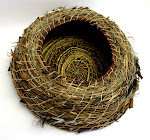Last year, I attended a seminar at Craft Queensland 'Best Foot Forward' which provided some strategies for documenting and presenting artworks and I have been having a go at photographing my own work. The results haven't been bad but time constraints (the demands of my teaching work and 2 young sons) meant that it always seemed a rushed job.
So, what a treat it was to drop Jonah and Ollie at mums and spend the afternoon with Jo, being bossy about what I wanted and enjoying spending time handling and looking at works that had been stored away for some time. I felt all soppy and nostalgic as each work held memories of the landscape that the fibres were collected from (we have arrived home from many road trips with the back of the car full to overflowing with an assortment of treasures found on the side of the road - much to my excitment and Noo's frustration). Anyway here's a few of the results.







